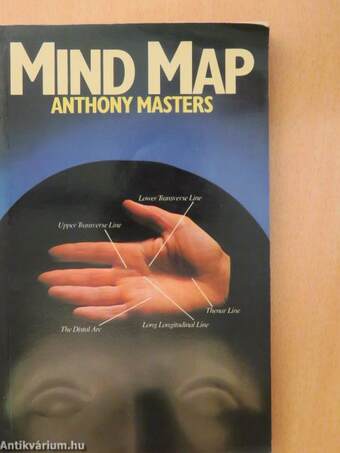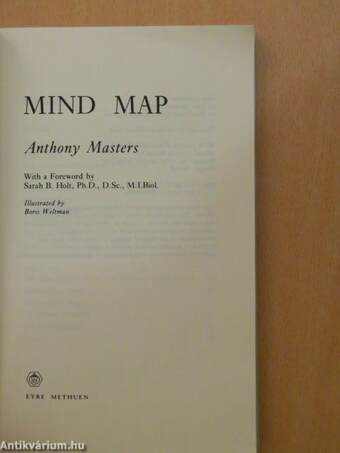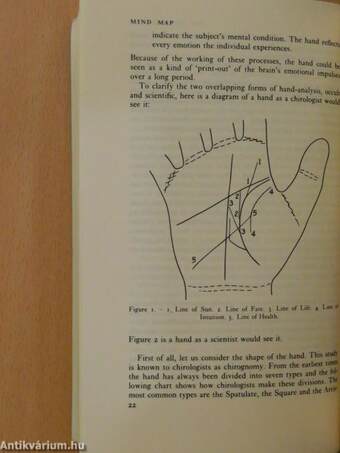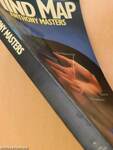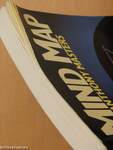1.067.317
kiadvánnyal nyújtjuk Magyarország legnagyobb antikvár könyv-kínálatát

VISSZA
A TETEJÉRE
JAVASLATOKÉszre-
vételek
Mind Map
| Kiadó: | Eyre Methuen |
|---|---|
| Kiadás helye: | London |
| Kiadás éve: | |
| Kötés típusa: | Ragasztott papírkötés |
| Oldalszám: | 163 oldal |
| Sorozatcím: | |
| Kötetszám: | |
| Nyelv: | Angol |
| Méret: | 22 cm x 14 cm |
| ISBN: | 0-413-34320-x |
| Megjegyzés: | Fekete-fehér ábrákkal. |
naponta értesítjük a beérkező friss
kiadványokról
naponta értesítjük a beérkező friss
kiadványokról
Előszó
Foreword
On louking at the palmar, or inner, side of a hand, certain features are apparent to the naked eye. There are four fingers and a thumb. The palm is not completely fiat, but has a number... Tovább
Előszó
Foreword
On louking at the palmar, or inner, side of a hand, certain features are apparent to the naked eye. There are four fingers and a thumb. The palm is not completely fiat, but has a number of raised parts or mounds. The palm is traversed by three major creases. There are other creases at the wrist, at the base of the fingers and at the joints between the phalanges of fingers and thumb. With a hand lens (magnifying glass) it can be seen that the entire palmar surface of the hand, including the fingers, is covered with narrow ridges, which in certain areas, for example the fingerballs, are arranged to form patterns. With higher magni-fication, such as a low-power binocular microscope, it is possible to see that the ridges do not continue unbroken across the surface, but are divided into pieces of varying length. Some ridges fork, others rejoin after forking. The width of the ridges also varies, not only on différent individuáis, but in différent parts. Each ridge has a row of pores, the openings of the sweat glands. There are so many variations in the detailed structure of the ridges that the features of even a small area are not repeated either in the same individual or in a différent one. Even the ridge détails of identical twins are not exactly alike.
Ridged skin is not limited to hands, but also occurs on soles and toes. It is present on the hands and feet of all primates, man, apes, monkeys and pro-simians (bushbabies). The study of ridged skin is called dermatoglyphics, a word coined in 1926 by Dr Harold Cummins, who was Professor of Anatomy at Tulane University, New Orleans, Louisiana, U.S.A., for many years. Various aspects of the subject are of interest to workers in a number of fields: identification experts, anthropologists, geneticists, cytologists, pae-diatricians, psychiatrists in hospitals for the mentally defective and primatologists, not to mention palmists, or chirologists, to give them their proper title. Some, or all, of the features mentioned in the first paragraph are used by one or other of the above-mentioned workers. The shape of the hand is notable; for one reason, because Vissza
Fülszöveg
In the past the only scientific method of attaining greater self-knowledge was thought to be psychiatry. There was never a physical guide to the personality, and indeed the existence of such a guide was to most people unthinkable. Gradually, however, médical science is coming to realize that a personality map does exist, and that this map, unique to each person, is conveniently displayed on the feet and palms of every human being. Until recently palmistry has been widely regarded as at best a purely occult field and at worst a stamping ground for charlatans. In Mind Map Anthony Masters looks briefly at the occult traditions of the past but focuses his attention on the work of scientists who have conducted research in this field during the present century, mainly doctors, psychiatrists, psychologists, biologists and geneticists. He shows how a thorough study of the configuration and surface of the human hand has already led to the use of finger printing for purposes of... Tovább
Fülszöveg
In the past the only scientific method of attaining greater self-knowledge was thought to be psychiatry. There was never a physical guide to the personality, and indeed the existence of such a guide was to most people unthinkable. Gradually, however, médical science is coming to realize that a personality map does exist, and that this map, unique to each person, is conveniently displayed on the feet and palms of every human being. Until recently palmistry has been widely regarded as at best a purely occult field and at worst a stamping ground for charlatans. In Mind Map Anthony Masters looks briefly at the occult traditions of the past but focuses his attention on the work of scientists who have conducted research in this field during the present century, mainly doctors, psychiatrists, psychologists, biologists and geneticists. He shows how a thorough study of the configuration and surface of the human hand has already led to the use of finger printing for purposes of identification and various forms of diagnosis of mental abnormality, for example mongolism, and could lead to a much more wide-ranging science of human potential which could be of value in aptitude tests as well as médical diagnosis. Vissza
Tartalom
Foreword vi
Introduction ix
PART ONE
The Historical Development of Palmistry i
PART TWO
The Ancient Art 17
PART THREE
The Scientific Hand 43
PART FOUR
The Spoilt Hand ll
PART FIVE
The Hands of Children 111
PART SIX
The Mind Map at Work: The Kennedy-Galton Centre 127 APPENDIX ONE 137
APPENDIX TWO
An Ancient Palmistry r47
Select Bibliography '53
Index



